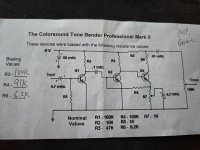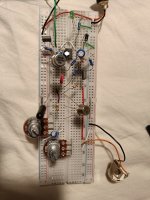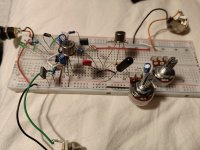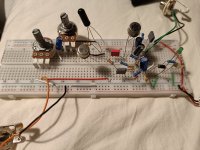Hi!
I'm currently building a Tone Vendor mk2. Bought a transistor set from Smallbear which came with the following components:
Q1 2n1305 - hfe: 67, leakage 40
Q2 OC75 - hfe: 70, leakage 270
Q3 2n1305 - hfe: 103, leakage 10
Smallbear suggest the following bias resistors:
R3 100k (R5 on the tone vendor pcb)
R4 91k
R6 6.2 k (R7 on the tone vendor pcb)
I have breadboarded the circuit and It works, but output volume is a bit low, about unity gain with the volume pot maxed. And the fuzz sounds undefined and gated/little sustain with attack pot on max.
The collector voltages with 9v power supply are:
Q1 c 8,29V
Q2 c 0.178V
Q3 c 8,7V
Is it possible to bias this circuit better? I have not tried any other Tone Bender circuits before so I am a bit unsure what I am aiming for and how it should behave.
Thanks!
I'm currently building a Tone Vendor mk2. Bought a transistor set from Smallbear which came with the following components:
Q1 2n1305 - hfe: 67, leakage 40
Q2 OC75 - hfe: 70, leakage 270
Q3 2n1305 - hfe: 103, leakage 10
Smallbear suggest the following bias resistors:
R3 100k (R5 on the tone vendor pcb)
R4 91k
R6 6.2 k (R7 on the tone vendor pcb)
I have breadboarded the circuit and It works, but output volume is a bit low, about unity gain with the volume pot maxed. And the fuzz sounds undefined and gated/little sustain with attack pot on max.
The collector voltages with 9v power supply are:
Q1 c 8,29V
Q2 c 0.178V
Q3 c 8,7V
Is it possible to bias this circuit better? I have not tried any other Tone Bender circuits before so I am a bit unsure what I am aiming for and how it should behave.
Thanks!





